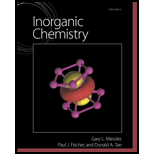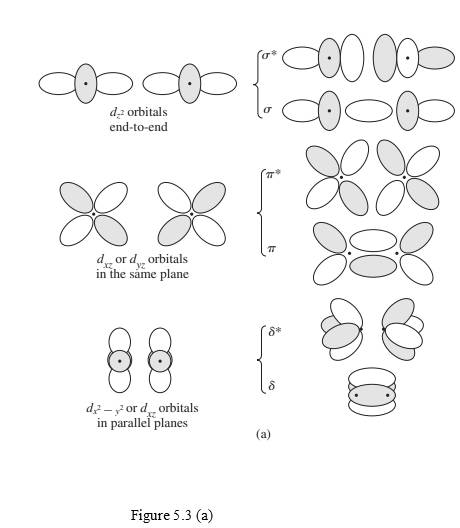
Inorganic Chemistry
5th Edition
ISBN: 9780321811059
Author: Gary L. Miessler, Paul J. Fischer, Donald A. Tarr
Publisher: Prentice Hall
expand_more
expand_more
format_list_bulleted
Concept explainers
Question
Chapter 5.2, Problem 5.2E
Interpretation Introduction
Interpretation: Molecular orbitals in figure 5.3(a) should be labeled as g or u.

Concept Introduction:
“gerade” (g) used to named orbitals which are symmetric to inversion.
“ungerade” (u) used to named orbitals which are anti-symmetric to inversion.
Expert Solution & Answer
Want to see the full answer?
Check out a sample textbook solution
Students have asked these similar questions
Protecting Groups and Carbonyls
6) The synthesis generates allethrolone that exhibits high insect toxicity but low mammalian toxicity. They are used in pet
shampoo, human lice shampoo, and industrial sprays for insects and mosquitos. Propose detailed mechanistic steps to
generate the allethrolone label the different types of reagents (Grignard, acid/base protonation, acid/base deprotonation,
reduction, oxidation, witting, aldol condensation, Robinson annulation, etc.)
III + VI
HS
HS
H+
CH,CH,Li
III
I
II
IV
CI + P(Ph)3
V
༼
Hint: no strong base added
VI
S
VII
IX
HO
VIII
-MgBr
HgCl2,HgO
HO.
isomerization
aqeuous solution
H,SO,
༽༽༤༽༽
X
MeOH
Hint: enhances selectivity for reaction at the S
X
☑
Draw the complete mechanism for the acid-catalyzed hydration of this alkene.
esc
田
Explanation
Check
1
888
Q
A
slock
Add/Remove step
Q
F4
F5
F6
A
བྲA
F7
$
%
5
@
4
2
3
&
6
87
Click and drag to start
drawing a structure.
© 2025 McGraw Hill LLC. All Rights Reserved. Terms of Use | Privacy Ce
W
E
R
T
Y
U
S
D
LL
G
H
IK
DD
요
F8
F9
F10
F1
*
(
8
9
0
O
P
J
K
L
Z
X
C
V
B
N
M
H
He
command
Explanation
Check
F1
H₂O
H₂
Pd
1) MCPBA
2) H3O+
1) Hg(OAc)2, H₂O
2) NaBH4
OH
CI
OH OH
OH
hydration
halohydrin formation
addition
halogenation
hydrogenation
inhalation
hydrogenation
hydration
☐ halohydrin formation
addition
halogenation
formation chelation
hydrogenation
halohydrin formation
substitution
hydration
halogenation
addition
Ohalohydrin formation
subtraction
halogenation
addition
hydrogenation
hydration
F2
80
F3
σ
F4
F5
F6
1
!
2
#
3
$
4
%
05
Q
W
&
Å
© 2025 McGraw Hill LLC. All Rights Reserved.
F7
F8
(
6
7
8
9
LU
E
R
T
Y
U
A
F9
Chapter 5 Solutions
Inorganic Chemistry
Ch. 5.1 - Repeat the process in the preceding example for...Ch. 5.2 - Prob. 5.2ECh. 5.3 - Use a similar approach to the discussion of HF to...Ch. 5.4 - Sketch the energy levels and the molecular...Ch. 5.4 - Using the D2h character table shown, verify that...Ch. 5.4 - Using orbital potential energies, show that group...Ch. 5.4 - Prob. 5.7ECh. 5.4 - Prob. 5.8ECh. 5.4 - Prob. 5.9ECh. 5.4 - Use the projection operator method to derive...
Ch. 5.4 - Determine the types of hybrid orbitals that are...Ch. 5.4 - Determine the reducible representation for all the...Ch. 5 - Expand the list of orbitais considered in Figures...Ch. 5 - On the basis of molecular orbitals, predict the...Ch. 5 - On the basis of molecular orbitals, predict the...Ch. 5 - Compare the bonding in O22,O2 and O2 Include Lewis...Ch. 5 - Although the peroxide ion, O22 and the acetylide...Ch. 5 - High-resolution photoelectron spectroscopy has...Ch. 5 - a. Prepare a molecular orbital energy-level...Ch. 5 - a. Prepare a molecular orbital energy-level...Ch. 5 - NF is a known molecule a. Construct a molecular...Ch. 5 - The hypofluorite ion, OF can be observed only with...Ch. 5 - Prob. 5.11PCh. 5 - Although KrF+ and XeF+ have been studied, KrBr+...Ch. 5 - Prepare a molecular orbital energy level diagram...Ch. 5 - Methylene, CH2 plays an important role in many...Ch. 5 - Beryllium hydride, BeH2 is linear in the gas...Ch. 5 - In the gas phase, BeF2 forms linear monomeric...Ch. 5 - For the compound XeF2 do the following: a. Sketch...Ch. 5 - TaH5 has been predicted to have C4v symmetry, with...Ch. 5 - Describe the bonding in ozone, o3 on the basis of...Ch. 5 - Describe the bonding in SO3 by using group theory...Ch. 5 - The ion H3+ has been observed, but its structure...Ch. 5 - Use molecular orbital arguments to explain the...Ch. 5 - Prob. 5.23PCh. 5 - Prob. 5.24PCh. 5 - The isomenc ions NSO (thiazate) and SNO...Ch. 5 - Apply the projection operator method to derive the...Ch. 5 - Apply the projection operator method to derive the...Ch. 5 - A set of four group orbitals derived from four 3s...Ch. 5 - The projection operator method has applications...Ch. 5 - Although the cl2+ ion has not been isolated, it...Ch. 5 - BF3 is often described as a molecule in which...Ch. 5 - SF4 has C2v symmetry. Predict the possible...Ch. 5 - Consider a square pyramidal AB5 molecule. Using...Ch. 5 - Prob. 5.34PCh. 5 - For the molecule PCl5 : a. Using the character...Ch. 5 - Molecular modeling software is typically capable...Ch. 5 - Prob. 5.39PCh. 5 - Calculate and display the orbitals for the linear...Ch. 5 - Prob. 5.41PCh. 5 - Prob. 5.42PCh. 5 - Prob. 5.43PCh. 5 - Diborane, B2H6 , has the structure shown. a. Using...
Knowledge Booster
Learn more about
Need a deep-dive on the concept behind this application? Look no further. Learn more about this topic, chemistry and related others by exploring similar questions and additional content below.Similar questions
- Show the mechanism steps to obtain the lowerenergy intermediate: *see imagearrow_forwardSoap is made by the previous reaction *see image. The main difference between one soap and another soap isthe length (number of carbons) of the carboxylic acid. However, if a soap irritates your skin, they mostlikely used too much lye.Detergents have the same chemical structure as soaps except for the functional group. Detergentshave sulfate (R-SO4H) and phosphate (R-PO4H2) functional groups. Draw the above carboxylic acidcarbon chain but as the two variants of detergents. *see imagearrow_forwardWhat are the reactions or reagents used? *see imagearrow_forward
- The two pKa values of oxalic acid are 1.25 and 3.81. Why are they not the same value? Show the protontransfer as part of your explanation. *see imagearrow_forwardасть Identify all the bonds that gauche interact with C-OMe in the most stable conformation of the above compound.arrow_forwardPredict the reactants used in the formation of the following compounds using Acid-Catalyzed dehydration reactionarrow_forward
- Can I please get help with this?arrow_forward.. Give the major organic product(s) for each of the following reactions or sequences of reactions. Show ll relevant stereochemistry [3 ONLY]. A H Br 1. NaCN 2 NaOH, H₂O, heat 3. H3O+ B. CH₂COOH 19000 1. LiAlH4 THF, heat 2 H₂O* C. CH Br 1. NaCN, acetone 2 H3O+, heat D. Br 1. Mg. ether 3. H₂O+ 2 CO₂ E. CN 1. (CH) CHMgBr, ether 2 H₂O+arrow_forwardAssign this COSY spectrumarrow_forward
arrow_back_ios
SEE MORE QUESTIONS
arrow_forward_ios
Recommended textbooks for you
 Organic Chemistry: A Guided InquiryChemistryISBN:9780618974122Author:Andrei StraumanisPublisher:Cengage Learning
Organic Chemistry: A Guided InquiryChemistryISBN:9780618974122Author:Andrei StraumanisPublisher:Cengage Learning

Organic Chemistry: A Guided Inquiry
Chemistry
ISBN:9780618974122
Author:Andrei Straumanis
Publisher:Cengage Learning